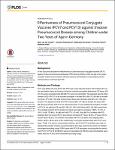Effectiveness of Pneumococcal Conjugate Vaccines (PCV7 and PCV13) against Invasive Pneumococcal Disease among Children under Two Years of Age in Germany
Linden, Mark van der
Falkenhorst, Gerhard
Perniciaro, Stephanie
Fitzner, Christina
Imöhl, Matthias
Background: In this study we calculate the effectiveness of pneumococcal conjugate vaccines (PCV) against invasive pneumococcal disease (IPD) among children under the age of two years using the indirect cohort method. We also discuss the timeliness of vaccination and the residual cases of vaccine type IPD. Methods and Findings: From July 2006 until June 2015, 921 IPD cases were reported and for 618 children (67.1%), the vaccination status at the time of infection could be accurately determined. Of these, 379 (61.3%) were vaccinated and 239 (38.7%) were not vaccinated. The adjusted vaccine effectiveness (VE) of PCV7 for all included serotypes + 6A was 80% (95% CI: 63–89) for at least one dose, 97% (89–100) after three primary doses (post primary) and 95% (57–100) post booster. The adjusted overall VE of PCV13 was 86% (74–93) for at least one dose, 85% (62–94) post primary and 91% (61–99) post booster. For the additional serotypes included in PCV13, the adjusted VE was 82% (66–91), 80% (46–93) and 90% (54–98) respectively. The serotype specific VE for at least one dose was high for serotypes 1 (83%; 15–97), 3 (74%; 2–93), 7F (84%; 18–98) and 19A (77%; 47–90). Only 39.5% of children with IPD obtained their first dose of PCV7 according to schedule (2nd dose: 32.9%, 3rd dose: 22.0%, booster dose: 63.6%). For children vaccinated with PCV13 values were slightly better: 43.8%, 33.5%, 26.3% and 74.3% respectively. Among 90 residual cases with PCV7 serotypes, 73 (81.1%) were in unvaccinated children, and 15 (16.7%) in children who had not obtained the number of doses recommended for their age, and only two (2.2%) in children vaccinated according to age. Of 82 cases with PCV13 serotypes occurring after the switch from PCV7 to PCV13, 56 (68.3%) were not vaccinated, 22 (26.8%) were incompletely vaccinated, and four (4.9%) were vaccinated according to age. Conclusions: Our data show a high effectiveness of pneumococcal conjugate vaccination in Germany. However, the administration of vaccine doses among children with IPD is often delayed, resulting in many vaccine type cases in non- or incompletely-vaccinated children. Whether the recently-implemented change to a 2+1 schedule will improve the timeliness of vaccination should be subject to careful monitoring.
No license information

